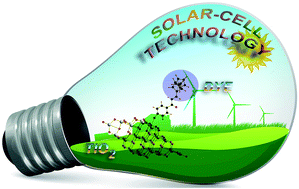Ferrocenyl chalcones with phenolic and pyridyl anchors as potential sensitizers in dye-sensitized solar cells†
Abstract
Five ferrocenyl chalcones viz. (E)-1-(3′-hydroxyphenyl)-3-ferrocenylprop-2-en-1-one (H-1), (E)-1-(4′-hydroxyphenyl)-3-ferrocenylprop-2-en-1-one (H-2), (E)-1-(2′-hydroxyphenyl)-3-ferrocenylprop-2-en-1-one (H-3), (E)-1-(4-pyridyl)-3-ferrocenylprop-2-en-1-one (H-4) and (E)-1-(2-pyridyl)-3-ferrocenylprop-2-en-1-one (H-5) having hydroxyl or pyridyl as the anchoring group have been synthesized and characterized using microanalyses, IR, 1H and 13C NMR, and in three cases, using single-crystal X-ray diffraction. UV-vis spectroscopic studies indicates that in comparison to ferrocene the electronic absorption bands of the synthesized dyes H-1–H-5 are bathochromically shifted up to 530 nm with concomitant enhancement in their intensities. The synthesized dyes have been exploited as photosensitizers in TiO2-based dye-sensitized solar cells (DSSCs). The photovoltaic performances and charge transport properties (EIS spectra) were studied to evaluate the synthesized dye performances in DSSCs. Amongst all the ferrocenyl chalcone dyes, those with the hydroxyl linker H-1–H-3 showed relatively superior photovoltaic performance in comparison to the dyes having a pyridyl anchor. The superior performances of H-1–H-3 are probably due to the better electronic communication between the ferrocene and the six-membered aromatic ring with anchoring group as well as the high dye loading abilities of these compounds on the TiO2 surface, which suppress charge recombination, prolong electron lifetime, and decreases the total resistance of DSSCs. The assembly fabricated using H-2 showed the best performance with an overall conversion efficiency η of 6.55%, Jsc of 11.99 mA cm−2 and Voc of −0.74 V. The long term stability of the photocurrent output of the cell using H-2 as photosensitizer has been monitored during 700 h which shows 92% retention of the cell parameters. Also, H-2 showed better thermal stability than the state-of-the-art N719 dye and also has a comparable lifetime of electrons in the conduction band.

- This article is part of the themed collection: Editors Collection for RSC Advances - India


 Please wait while we load your content...
Please wait while we load your content...